I am not able to change the password of the logged in Azure AD B2C user.
I have Azure B2C tenant which is used for dev and QA.Also, i have two applications something-Local and something-QA used for DEV and QA respectively in Azure B2C as shown below and I have verified the settings of both the apps they are same  Below are the configurations of the applications
Here is my code which is used for B2C connection
Below are the configurations of the applications
Here is my code which is used for B2C connection
private OpenIdConnectAuthenticationOptions CreateOptionsFromPolicy(string policy)
{
return new OpenIdConnectAuthenticationOptions
{
// For each policy, give OWIN the policy-specific metadata address, and
// set the authentication type to the id of the policy
// meta data
MetadataAddress = "https://login.microsoftonline.com/" + "mytenant" + "/v2.0/.well-known/openid-configuration?p=" + policy,
AuthenticationType = policy,
// These are standard OpenID Connect parameters, with values pulled from web.config
ClientId = AzureAdConfig.ClientId,
Notifications = new OpenIdConnectAuthenticationNotifications
{
AuthorizationCodeReceived = OnAuthorizationCodeReceived,
AuthenticationFailed = OnAuthenticationFailed,
SecurityTokenValidated = OnSecurityTokenValidated,
RedirectToIdentityProvider = OnRedirectToIdentityProvider,
},
Scope = "openid",
ResponseType = "id_token",
// This piece is optional - it is used for displaying the user's name in the navigation bar.
TokenValidationParameters = new TokenValidationParameters
{
NameClaimType = "name",
}
};
}
in the above code the ClientID used for QA and Dev are different. Below is the code used to change the user password using graph API.
public async Task<HttpResponseMessage> ChangePassword(string currentPassword, string newPassword)
{
string userId = ClaimValues.ObjectIdentifier();
var adUser = _activeDirectoryClient.Users
.Where(u => u.ObjectId.Equals(userId))
.ExecuteAsync().Result.CurrentPage.FirstOrDefault();
string upn = adUser.UserPrincipalName;
var client = new HttpClient();
string uriString = "https://login.microsoftonline.com/"+ AzureAdConfig.Tenant + "/oauth2/token";
Uri requestUri = new Uri(uriString);
string requestString = "resource=https%3a%2f%2fgraph.windows.net&client_id=" + AzureAdConfig.AppId + "&grant_type=password&username=" + upn + "&password=" + currentPassword + "&client_secret=" + AzureAdConfig.AppKey;
var tokenResult = await client.PostAsync(requestUri, new StringContent(requestString, Encoding.UTF8, "application/x-www-form-urlencoded"));
if (tokenResult.IsSuccessStatusCode)
{
var stringResult = await tokenResult.Content.ReadAsStringAsync();
GraphApiTokenResult objectResult = JsonConvert.DeserializeObject<GraphApiTokenResult>(stringResult);
client = new HttpClient();
string requestUrl = AzureAdConfig.GraphResourceId + AzureAdConfig.Tenant + "/me/changePassword?" + AzureAdConfig.GraphVersion;
Uri graphUri = new Uri(requestUrl);
client.DefaultRequestHeaders.Authorization = new System.Net.Http.Headers.AuthenticationHeaderValue("Bearer", objectResult.access_token);
requestString = JsonConvert.SerializeObject(new
{
currentPassword = currentPassword,
newPassword = newPassword
});
var response = await client.PostAsync(graphUri, new StringContent(requestString, Encoding.UTF8, "application/json"));
return response;
}
else
{
return tokenResult;
}
}
Also, i wanted to understand what is the difference between Application Registrations in Azure Active directory service of azure and the Application in Azure AD B2C of azure?
Thanks in advance